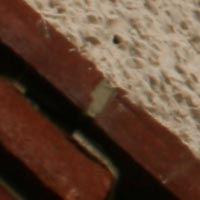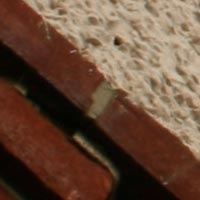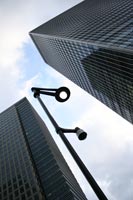Canon EOS 400D Review
(also called the Canon Digital Rebel XTi)
Date: December 4th 2006
Author: Michael Roscoe
Leave a Comment about this Review
|
Image Quality
All of the sample images in this Review were taken using the JPEG fine setting with the large (3888x2592/10M) image size option producing a file that is between 3-6.5Mb.
Noise
The Canon EOS 400D only has five ISO settings which can be altered in the 'creative zone' (manual and semi-manual modes) via the ISO button on the back of the body. Here are some 100% crops that show the noise levels for each ISO setting. The Canon EOS 400D performed remarkably well up to ISO 800 with hardly any signs of noise or purple fringing. Even at ISO 1600 there was hardly any noticeable grain.
ISO 100 (100% Crop) |
ISO 200 (100% Crop) |
 |
 |
ISO 400 (100% Crop) |
ISO 800 (100% Crop) |
 |
 |
ISO 1600 (100% crop) |
|
 |
|
Sharpening
Here are two 100% crops which have been Saved as Web - Quality 50 in Photoshop. The right-hand image has had some sharpening applied in Photoshop. The out-of-the camera images are slightly soft at the default setting and ideally benefit from some further sharpening in a program like Adobe Photoshop. You can also change the in-camera sharpening level to suit your tastes.
Original
(100% Crop) |
Sharpened (100% Crop) |
 |
 |
 |
 |
File Quality
The Canon EOS 400D has two different file quality settings plus a RAW mode. Fine is the highest quality JPEG option and RAW produces the largest file size. These 100% crops display the quality of the different options, with the file size shown in brackets.
| RAW
(8.77Mb) (100% Crop) |
10M
Fine (2.8Mb) (100% Crop) |
 |
 |
| 10M
Normal (1.41Mb) (100% Crop) |
|
 |
|
RAW Format
The Canon EOS 400D enables users to capture both RAW and JPEG image files.
| JPG
(4.41Mb) |
RAW
(14.27Mb) |
 |
 |
Chromatic Aberrations
The Canon EOS 400D displays some evidence of purple fringing but this is usually only evident in high-contrast light conditions.
| Chromatic
Aberrations #1 (100% Crop) |
Chromatic
Aberrations #2 (100% Crop) |
 |
 |
Macro
Most Canon EOS 400D users will probably find that they want to replace the bundled EF-S 18-55mm 1:3.5-5.6 II lens after a short while. It does not produce a good performance for capturing most photographic subject matter and its macro capabilities are limited to say the least. It is only able to focus on a subject that is 12cm away, and that can only be described as close up. The first image shows how close you can get to the subject (in this case a compact flash card). The second image is a 100% crop.
| Macro Shot |
Macro Shot (100% Crop) |
 |
 |
Flash
The pop-up flash on the 400D can be used automatically, with the Night Portrait exposure option (slow sync), red-eye reduction and there is a flash exposure comp option. These shots of a white wall were taken at a distance of 1.5m. Below are also some test shots in the different flash modes.
| Flash Off - Wide Angle (29mm) |
Auto Flash - Wide Angle (29mm) |
 |
 |
| Flash Off - Telephoto (88mm) |
Auto Flash - Telephoto (88mm) |
 |
 |
And here are some self-portrait shots. Both the Flash On and Red-Eye Reduction settings caused a tiny amount of red-eye.
| Flash On |
Flash On (100% Crop) |
 |
 |
| Flash - Red-Eye Reduction |
Flash - Red-Eye Reduction (100% Crop) |
 |
 |
Night Shot
The Canon EOS 400D maximum shutter speed is 30 seconds and there is also a Bulb mode for longer exposures, which is great for night photography. The shot below was taken using a shutter speed of 1/50th second, f/5.6 at ISO 1600. I've included a 100% crop of the image to show what the quality is like.
| Night Shot |
Night Shot (100% Crop) |
 |
 |
Overall Image Quality
The quality of the final image is certainly helped by the Canon 10.1 megapixel CMOS sensor and their in-camera processing and bundled software solution. However, the use of the EF-S 18-55mm 1:3.5-5.6 II kit lens produces results that are less satisfactory. This Canon EF-S lens offers users an aperture range from f/3.5-f/22 at its widest 28mm setting, but it is reduced by half a stop at its longest focal length, offering a spectrum from f/5.6 to f/22. The wide-angle focal length of this lens produced obvious barrel distortion, it is not very resistant to flare and should only be used to get new owners started. Serious enthusiasts will want to invest in better glass and then they won't be disappointed with their final images. The Canon EOS 400D performed remarkably well up to ISO 800 with hardly any sign of noise or purple fringing. Even at ISO 1600 there was hardly any noticeable grain and little sign of any visible electronic interference in the highlight or shadow areas. Once the camera was set to its highest resolution JPEG setting, it was capable of being output at 32.92 x 21.95cm (300ppi) and could handle being reproduced at A3 size with few signs of any pixelation. Image fanatics will concur that the 400D offers superb value for money and its image quality is excellent with accurately reproduced colours and tones, subtle saturation and little evidence of chromatic aberrations or evidence of purple fringing.
|
![]() PhotographyBLOG
is a member of the DIWA
organisation. Our test results for the Canon EOS 400D have
been submitted to DIWA
for comparison with test results for different samples of
the same camera model supplied by other DIWA
member sites.
PhotographyBLOG
is a member of the DIWA
organisation. Our test results for the Canon EOS 400D have
been submitted to DIWA
for comparison with test results for different samples of
the same camera model supplied by other DIWA
member sites.
